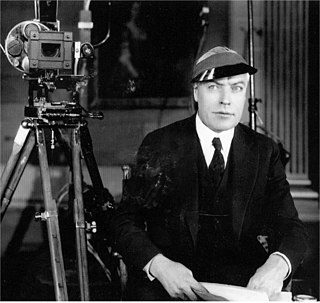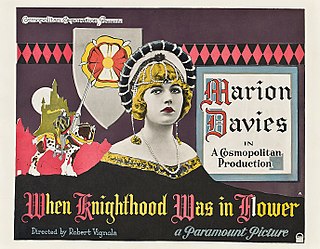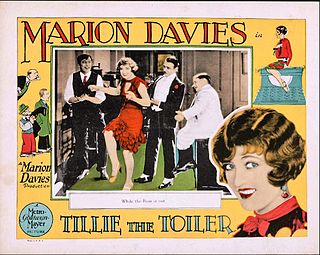
Sidney Olcott was a Canadian-born film producer, director, actor and screenwriter.

Marion Davies was an American actress, producer, screenwriter, and philanthropist. Educated in a religious convent, Davies fled the school to pursue a career as a chorus girl. As a teenager, she appeared in several Broadway musicals and one film, Runaway Romany (1917). She soon became a featured performer in the Ziegfeld Follies.

Beverly of Graustark is a 1926 American silent romantic comedy film directed by Sidney Franklin and starring Marion Davies, Antonio Moreno, and Creighton Hale. The film's screenplay was written by Agnes Christine Johnston based on the novel by George Barr McCutcheon, and set in the fictional land of Graustark. The film features a final sequence in Technicolor. It was the first film by Sidney Franklin for MGM.

Show People is a 1928 American silent comedy film directed by King Vidor. The film was a starring vehicle for actress Marion Davies and actor William Haines and included notable cameo appearances by many of the film personalities of the day, including stars Charlie Chaplin, Douglas Fairbanks, William S. Hart and John Gilbert, and writer Elinor Glyn. Vidor also appears in a cameo as himself, as does Davies.

Robert G. Vignola was an Italian-American actor, screenwriter, and film director. A former stage actor, he appeared in many motion pictures produced by Kalem Company and later moved to directing, becoming one of the silent screen's most prolific directors. He directed a handful of films in the early years of sound films, but his career essentially ended in the silent era.

Cain and Mabel is a 1936 American romantic comedy film directed by Lloyd Bacon and designed as a vehicle for Marion Davies in which she co-stars with Clark Gable. The story had been filmed before, in 1924, by William Randolph Hearst's production company, Cosmopolitan, as a silent called The Great White Way, starring Anita Stewart and Oscar Shaw. In this version, Robert Paige introduced the song "I'll Sing You a Thousand Love Songs", with music by Harry Warren and words by Al Dubin, who also wrote "Coney Island", "Here Comes Chiquita", and other songs.

Quality Street is a 1927 American silent romance film directed by Sidney Franklin and starring Marion Davies, Conrad Nagel and Helen Jerome Eddy. Produced by Cosmopolitan Productions for release through MGM, it was based on the 1901 play of the same name by James M. Barrie. Prints of this film are preserved at the Library of Congress and in the Turner Archive.

The Patsy is a 1928 American silent comedy-drama film directed by King Vidor, co-produced by and starring Marion Davies for Cosmopolitan Productions, and released by Metro-Goldwyn-Mayer. It was based on a play of the same name by Barry Conners, and served as Marie Dressler's comeback film after a long slump in her film career. Davies played the dowdy and downtrodden Patricia, the younger daughter in a household ruled by an imperious mother (Dressler) and selfish sister.
Cosmopolitan Productions, also often referred to as Cosmopolitan Pictures, was an American film company based in New York City from 1918 to 1923 and Hollywood until 1938.

Little Old New York is a 1940 American black-and-white historical drama from 20th Century Fox, produced by Darryl F. Zanuck, directed by Henry King, that stars Alice Faye, Fred MacMurray, and Richard Greene. The film is based on a play by Rida Johnson Young, which opened on Broadway on September 8, 1920, and starred Genevieve Tobin, Douglas Wood, and Donald Meek.

The Restless Sex is a 1920 American silent drama film starring Marion Davies, and Ralph Kellard. It was directed by Leon D'Usseau and Robert Z. Leonard and written by Frances Marion. The film is based upon the 1918 novel of the same name by Robert W. Chambers and was distributed by Paramount Pictures under the Famous Players–Lasky Corporation name.

Lights of Old Broadway is a 1925 American silent drama film directed by Monta Bell, produced by William Randolph Hearst's Cosmopolitan Productions, and released by Metro-Goldwyn-Mayer. The film stars Marion Davies in a dual role and Conrad Nagel, and is an adaptation of the play The Merry Wives of Gotham by Laurence Eyre (USA). The film has color sequences using tinting, Technicolor, and the Handschiegl color process.

Zander the Great is a 1925 American silent comedy drama film directed by George W. Hill, in his first directing role for MGM. The film stars Marion Davies. The screenplay by Frances Marion is based upon the Edward Salisbury Field 1923 play of the same name.

When Knighthood Was in Flower is a 1922 American silent historical film directed by Robert G. Vignola, based on the novel by Charles Major and play by Paul Kester. The film was produced by William Randolph Hearst for Marion Davies and distributed by Paramount Pictures. This was William Powell's second film. The story was re-filmed by Walt Disney in 1953 as The Sword and the Rose, directed by Ken Annakin.

The Fair Co-Ed, also known as The Varsity Girl, is a 1927 American silent film comedy starring Marion Davies and released through MGM. The film was produced by William Randolph Hearst, through Cosmopolitan Productions and directed by Sam Wood.
Yolanda is a 1924 American silent historical drama film produced by William Randolph Hearst and starring Marion Davies. Robert G. Vignola directed as he had Enchantment (1921) and several other Davies costume films. The film began production as a Metro-Goldwyn film, with the company becoming Metro-Goldwyn-Mayer in May 1924.

The Bride's Play is a 1922 American silent romance film produced by William Randolph Hearst as a starring vehicle for Marion Davies. It was directed by George Terwilliger and distributed by Paramount Pictures. It is an extant film that is preserved at the Library of Congress.

Tillie the Toiler is a 1927 American silent film comedy produced by Cosmopolitan Productions and released through Metro Goldwyn Mayer studios. It is based on Russ Westover's popular comic strip Tillie the Toiler. The film was directed by Hobart Henley and stars Marion Davies.

April Folly is a 1920 American silent drama film directed by Robert Z. Leonard and written by Adrian Johnson and Cynthia Stockley. The film stars Marion Davies, Madeline Marshall, Hattie Delaro, Amelia Summerville, Conway Tearle, J. Herbert Frank, and Warren Cook. The film was released on March 21, 1920, by Paramount Pictures.

Adam and Eva is a 1923 American comedy silent film directed by Robert G. Vignola and adapted by Luther Reed from the play by Guy Bolton and George Middleton. The film stars Marion Davies, T. Roy Barnes, Tom Lewis, William Norris, Percy Ames, Leon Gordon, and Luella Gear. Marion Davies plays an extravagant girl who, when her father goes bust, reforms by learning the simple life and making a farm a thriving business venture. The film was released on February 11, 1923, by Paramount Pictures.


















